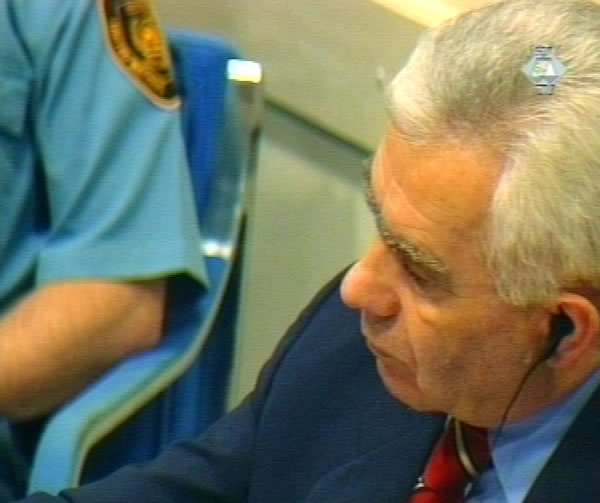Home
ESCALATION OF PERSECUTION IN KOTOR VAROS
A protected witness at the trial of Momcilo Krajisnik describes how Muslims and Croats were forced to leave Kotor Varos in a "persecution campaign" which, according to the prosecutor, "escalated to the level of destruction" of parts of both ethnic groups.
 Momcilo Krajisnik in the courtroom
Momcilo Krajisnik in the courtroom At the trial of Momcilo Krajisnik, a resident of Kotor Varos in 1992--protected witness 144--described events on the eve of and after 11 June 1992 when Serb forces took control of the municipality.
The witness was a member of the municipal National Defense Council, participating in meetings where incidents involving unfair treatment of Muslim and Croat employees in companies and institutions in Kotor Varos were discussed. Witness 144 testified that being of Muslim ethnic origin, he was himself removed from a position as company manager.
“My manager told me that I would not be out of a job because he will keep me as an adviser of sorts, but that managerial duties would be taken on by lower-level managers subordinate to me," the witness said. He also described how his manager "evaded answering my question about who had given him orders to remove from managerial positions all Muslims and Croats."
The witness was detained from July to December 1992, first in the elementary school and then in the prison in Kotor Varos. He described how about 100 detainees of Muslim and Croat ethnic origin slept on the floor in the school, how they had no water and basic sanitation, and how he had been unable "for two whole months to wash off the blood stains from his clothes" - the result of a beating at the police station he received prior to being detained. The conditions in the prison where he was transferred were no better: he was put in a 25 square meter room together with about 80 other detainees. He was beaten several times by members of the special forces; their commander, he stated, was a man named Zdravko Samardzija.
The witness said he heard from survivors of events in the Kotor Varos Health Care Center what had happened there on 25 June 1992. "Some of the Muslim civilians from the Kukavica neighborhood who were brought to the Health Care Center were shot straight away; others were tortured," the witness said. Enes Terzic was among them. The witness recounted how Terzic showed him "deep wounds on his leg he received when dogs were sicced on him."
Confirming the information contained in a number of documents shown to him by the prosecutor – mostly minutes of the meetings of the Kotor Varos War Presidency and Crisis Staff – and TV reports about events in the summer of 1992, the witness said that after the takeover, a vehicle drove around town informing the population over a loudspeaker that their movements were restricted to the period between 9 and 11 o'clock, and that "those who want to leave Kotor Varos and have committed no crimes against the Serb people can report to the Relocation Agency." Those who did that, the witness said, had to sign a document to the effect "that they were leaving voluntarily all their property to the Serb Republic and that they would pay the travel expenses to their chosen destination themselves."
According to official data, about 22,000 Bosniaks and Croats lived in the Kotor Varos municipality in 1991. By the end of 1992, there were virtually none left.
Kotor Varos is listed in the indictment against Momcilo Krajisnik as one of 37 municipalities where Muslims and Croats were persecuted, detained, tortured and killed in 1992. In some of those municipalities, including Kotor Varos, the persecution campaign escalated to the level which, according to prosecutors, included acts committed with the intent "to partially destroy the ethnic, racial or religious group of Bosnian Muslims and Bosnian Croats as such" and constitutes the basis for the genocide charge against Momcilo Krajisnik.
